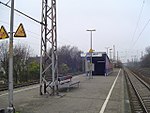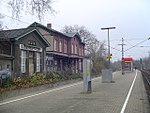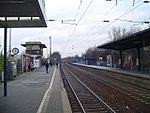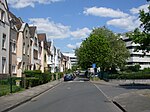Düsseldorf-Eller Mitte station
Düsseldorf VRR stationsNorth Rhine-Westphalia railway station stubsRailway stations in DüsseldorfRailway stations in Germany opened in 1980Rhine-Ruhr S-Bahn stations ... and 2 more
Rhine-Ruhr S-Bahn stubsS1 (Rhine-Ruhr S-Bahn)

Düsseldorf-Eller Mitte station is located in the district of Eller in the German city of Düsseldorf in the German state of North Rhine-Westphalia. It is on the Düsseldorf–Solingen line and is classified by Deutsche Bahn as a category 5 station. It is served by Rhine-Ruhr S-Bahn line S 1 every 20 minutes, Stadbahn line U 75, operating every 10 minutes, tram line 705, operating every 10 minutes and two bus routes: 723 (every 30 minutes) and 724 (every 20 minutes), operated by Rheinbahn.
Excerpt from the Wikipedia article Düsseldorf-Eller Mitte station (License: CC BY-SA 3.0, Authors, Images).Düsseldorf-Eller Mitte station
Am Krahnap, Dusseldorf Eller (Stadtbezirk 8)
Geographical coordinates (GPS) Address Nearby Places Show on map
Geographical coordinates (GPS)
| Latitude | Longitude |
|---|---|
| N 51.20249 ° | E 6.841162 ° |
Address
Am Krahnap 37
40229 Dusseldorf, Eller (Stadtbezirk 8)
North Rhine-Westphalia, Germany
Open on Google Maps










